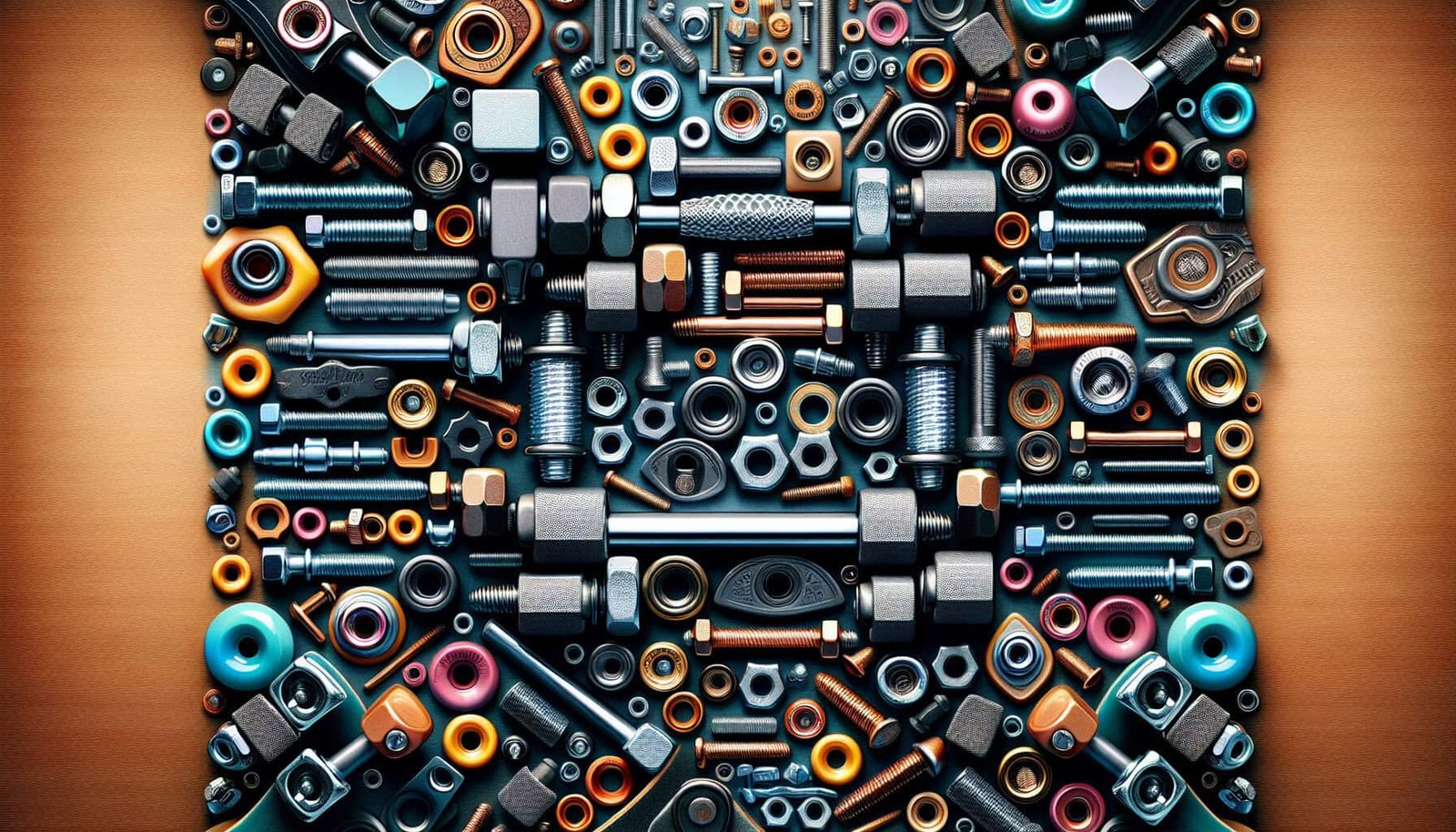If you’re a skateboard enthusiast or just starting out in the world of skateboarding, you might be wondering about the various options available when it comes to skateboard hardware. From choosing the right size to picking the perfect design, the possibilities can seem endless. In this article, we will explore the different options for skateboard hardware, giving you all the information you need to make an informed decision and enhance your skateboarding experience. So, let’s get started!

Skateboard Hardware
Skateboard hardware refers to the nuts, bolts, and other components that hold the skateboard together. It plays a crucial role in ensuring the stability and safety of the skateboard. Choosing the right skateboard hardware is essential for a smooth and enjoyable skateboarding experience.
Definition and Importance of Skateboard Hardware
Skateboard hardware consists of bolts, nuts, washers, and other small parts that secure the skateboard trucks to the deck. It helps in connecting the trucks to the deck and ensures that they remain securely attached during skateboarding.
The importance of skateboard hardware cannot be understated. It is responsible for maintaining the overall structure and stability of the skateboard. Properly installed and functional hardware prevents the trucks from becoming loose or detached, which can lead to accidents and injuries. It is crucial to invest in high-quality hardware to ensure the durability and safety of the skateboard.
Components of Skateboard Hardware
Skateboard hardware includes several components that work together to hold the skateboard together. The main components of skateboard hardware are:
Bolts: These are the threaded fasteners that secure the trucks to the skateboard deck. They typically come in sets of eight.
Nuts: Nuts are used in conjunction with bolts to secure the trucks. They are threaded onto the bolts and tightened to hold the trucks firmly in place.
Washers: Washers are flat, metal discs that are placed between the nut and the skateboard deck. They distribute the pressure evenly and help prevent damage to the deck.
Choosing the Right Skateboard Hardware
When selecting skateboard hardware, there are several factors to consider. These include size options, design options, hardware length, bolt materials, riser pad options, griptape options, bearing spacers, nut options, and tool options. Let’s explore each of these components in detail.
Size Options
When it comes to skateboard hardware, size options refer to the length of the bolts. The two main size options for skateboard hardware are standard size and longboard hardware.
Standard Size Hardware
Standard size hardware is the most common option and is suitable for most skateboard decks. It typically consists of 1-inch bolts, which are long enough to securely attach the trucks to the deck without sticking out too far.
Longboard Hardware
Longboard hardware, as the name suggests, is designed specifically for longboard skateboards. Longboards often have thicker decks, requiring longer bolts to ensure a secure attachment. Longboard hardware usually consists of 1.25 to 2-inch bolts, providing the necessary length for the trucks to properly mount onto the longboard deck.
Design Options
Skateboard hardware comes in various designs, allowing skaters to customize the look of their skateboard. The design options for skateboard hardware include:
Traditional Bolt Design
Traditional bolt design refers to the standard hexagonal head bolts. They feature a six-sided head and are the most common type of skateboard hardware.
Phillips Bolt Design
Phillips bolt design features a cross-shaped indentation on the head. It requires a Phillips screwdriver to tighten or loosen the bolts.
Allen/Hex Bolt Design
Allen/hex bolt design is characterized by a hexagonal socket on the head, requiring an Allen wrench or hex key to tighten or loosen the bolts.
Button Head Bolt Design
Button head bolt design features a low-profile, rounded head. It provides a clean and sleek look to the skateboard.
Socket Head Bolt Design
Socket head bolt design is similar to the button head design but with a cylindrical head. It offers a unique aesthetic while maintaining a low-profile design.
Colored Bolt Design
Colored bolt design allows skaters to add a pop of color to their skateboard. These bolts come in a variety of vibrant colors, allowing for customization and personalization.
Hardware Length
The hardware length refers to the measurement from the bottom of the bolt head to the end of the bolt. It is an important factor to consider when choosing skateboard hardware.
Determining the Correct Hardware Length
To determine the correct hardware length, you need to consider the thickness of your deck and the height of your trucks. The hardware should be long enough to securely attach the trucks to the deck without protruding too far. If the hardware is too short, it may not provide a secure connection, while if it is too long, it may stick out and cause interference while riding.
Effects of Long and Short Hardware
Using long hardware can create more space between the deck and trucks, resulting in higher ride height. This can be beneficial for skaters who prefer more clearance or need to accommodate larger wheels. On the other hand, short hardware reduces the ride height and brings the deck closer to the ground, providing increased stability and control.

Bolt Materials
The material of the bolts can affect their strength, durability, and weight. The common bolt materials used in skateboard hardware are steel, titanium, and plastic.
Steel Bolts
Steel bolts are the most common and affordable option. They offer good strength and durability, making them ideal for most skateboarders. Steel bolts are resistant to wear and can withstand the impact and forces of skateboarding.
Titanium Bolts
Titanium bolts are lighter than steel bolts while offering similar strength and durability. They are a popular choice among skaters who prioritize weight reduction in their setups. Titanium bolts can provide a slight weight advantage without compromising on performance.
Plastic Bolts
Plastic bolts are the lightest option available. They are typically made from high-grade nylon or other durable plastics. While plastic bolts may not offer the same strength as steel or titanium bolts, they can be suitable for skaters who prioritize weight reduction and have less impact on their setups.
Riser Pad Options
Riser pads are small rubber or plastic pads that are placed between the skateboard deck and the trucks. They provide additional cushioning and help absorb shocks and impacts while skateboarding.
Definition and Purpose of Riser Pads
Riser pads are used to increase the distance between the skateboard deck and the trucks. They are particularly useful for preventing wheel bite, which occurs when the wheels come into contact with the deck during tight turns or sharp maneuvers. Riser pads also help reduce vibrations and provide a smoother ride.
Choosing the Right Riser Pads
When selecting riser pads, it is important to consider the thickness of the pads. Thicker riser pads provide more clearance and are suitable for larger wheels or riders who want a higher ride height. Thinner riser pads are ideal for skaters who prioritize a lower ride height or have smaller wheels.

Griptape Options
Griptape is a rough, sandpaper-like material applied to the top surface of the skateboard deck. It provides traction and grip, allowing skaters to have better control over their board.
Definition and Importance of Griptape
Griptape is an essential component of a skateboard setup. It ensures that your feet stay firmly planted on the board while performing tricks and maneuvers. Griptape allows skaters to maintain stability, balance, and control during their rides.
Different Grip Patterns and Materials
Griptape comes in various patterns, allowing skaters to choose the style that suits their preferences. Some common grip patterns include standard black, clear, camo, and custom designs. Griptape is typically made from a layer of adhesive-backed sandpaper or synthetic materials designed to mimic the texture and grip of traditional sandpaper.
Choosing the Right Griptape
Choosing the right griptape depends on personal preference and the type of skateboarding you do. Consider factors such as the grip pattern, durability, and the feel of the grip under your shoes. Griptape should provide enough traction to keep your feet securely on the board without being too abrasive or uncomfortable.
Bearing Spacers
Bearing spacers are small metal or plastic tubes that fit between the skateboard bearings. They help maintain consistent spacing and alignment of the bearings, reducing friction and prolonging their lifespan.
Definition and Function of Bearing Spacers
Bearing spacers serve multiple functions in a skateboard setup. They ensure that the bearings are aligned correctly within the wheels, reducing the risk of wheel wobble and uneven wear. Bearing spacers also help distribute the load evenly across the bearings, allowing for smoother and more efficient rolling.
Benefits of Using Bearing Spacers
Using bearing spacers can provide several benefits for skateboarders. They promote more even wear on the bearings, increasing their longevity. Bearing spacers also help reduce friction and drag, allowing for smoother and faster rides. Additionally, they contribute to improved stability and prevent wheel wobble during high-speed maneuvers.

Nut Options
Nuts are an integral part of skateboard hardware, securing the bolts and maintaining the stability of the skateboard. There are two main options for skateboard nuts: standard nuts and Nyloc nuts.
Standard Nuts
Standard nuts are the most commonly used nuts in skateboard hardware. They are easily recognizable and can be found in any skateboard shop. Standard nuts provide a secure connection when properly tightened.
Nyloc Nuts
Nyloc nuts, short for nylon-insert lock nuts, have a nylon collar inside the nut itself. This nylon collar creates friction that resists loosening due to vibrations and impacts. Nyloc nuts are ideal for skaters who want an added level of security and vibration resistance.
Tool Options
Skateboard tools are essential for assembling and maintaining a skateboard. They provide convenience and ease when adjusting the hardware and performing regular maintenance.
Skateboard Tools
Skateboard tools are specifically designed for skateboard hardware, featuring multiple tools in a compact and portable design. They typically include a socket for the nuts, a wrench for the bolts, and an Allen key for various components.
Alternative Tools for Skateboard Assembly
In the absence of a skateboard tool, you can use alternative tools to assemble your skateboard. For example, a socket wrench or an adjustable wrench can be used to tighten the nuts, while a screwdriver or an Allen wrench can be used for the bolts. However, investing in a skateboard tool is recommended for its convenience and versatility.
In conclusion, skateboard hardware plays a crucial role in maintaining the stability and safety of a skateboard. When choosing skateboard hardware, consider factors such as size options, design options, hardware length, bolt materials, riser pad options, griptape options, bearing spacers, nut options, and tool options. By selecting the right hardware components, you can ensure a smooth and enjoyable skateboarding experience while personalizing the look and feel of your skateboard.


